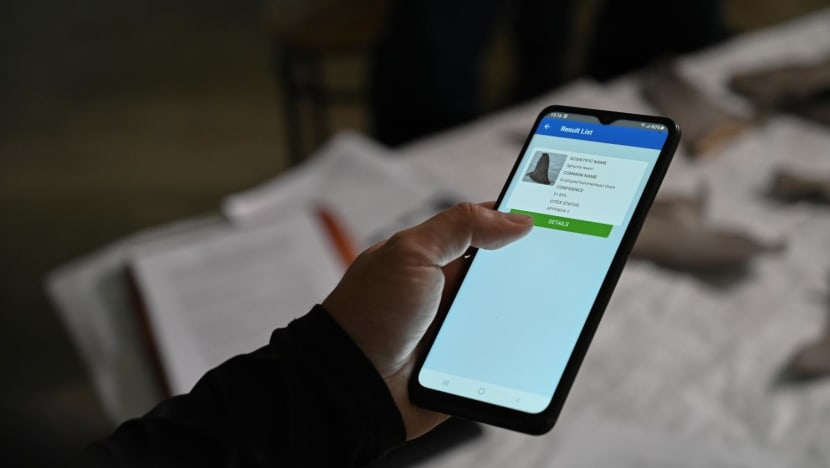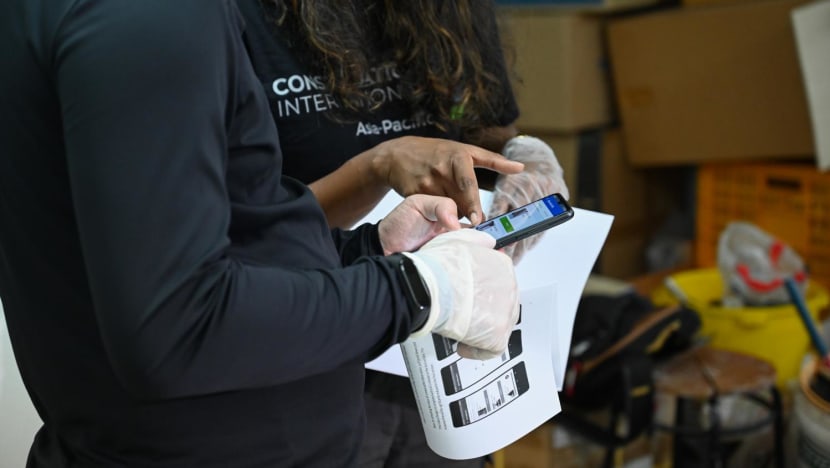Mobile app that identifies sharks’ fins to help curb illegal wildlife trade

A Singapore National Parks Board (NParks) inspector pilot tests Fin Finder on a shark fin to determine the species ID and other valuable information that helps determine the legality of the traded specimen. (Photo: Microsoft, Conservation International and the Singapore National Parks Board)
SINGAPORE: Conservationists and customs officers now have a mobile app to help them track down sharks’ fins illegally crossing international borders.
The Fin Finder app, developed by Singapore’s National Parks Board (NParks), Microsoft and Conservation International, uses artificial intelligence (AI) to identify shark and ray species by scanning the fins.
There are about 1,000 species of sharks and rays in the world, of which 30 species are listed as endangered, and their trade is regulated.
In Singapore, more than 160,000kg of fins from endangered sharks and rays listed in the Convention on International Trade in Endangered Species of Wild Fauna and Flora (CITES) have entered the country’s borders between 2012 and 2020, said NParks.
This is about 9 per cent of global trade, and the shipments mainly go through Singapore to other parts of Asia.
Currently, officers from NParks and at checkpoints take about a week to determine the species of fins in each shipment by cross-checking with paper lists and sending them for DNA testing. The app cuts to seconds the time required to sift out possibly illegal fins.
The officers take photos of fins that are matched against a database of more than 15,000 shark and ray fin images using an AI-driven algorithm in the app. They can then flag suspicious fin shipments for further DNA testing.
Mr Eric Fegraus, senior director of conservation technology at Conservation International, said that a key challenge faced by customs inspectors around the world is having to identify thousands of species of animals, a “superhuman” task which could puzzle even experts.
“This is a huge challenge, but one where we thought there's a real opportunity for technology to make a difference,” he said at a press briefing on Tuesday (Jun 7).
“This led us to create the wildlife protection partnership with a mission to utilise technologies, like artificial intelligence, to stop and deter illegal wildlife trafficking.”


Dr Adrian Loo, group director of wildlife management at NParks, said that Fin Finder can help strengthen enforcement against the illegal trade of sharks and ray species and boost Singapore’s capabilities in conserving biodiversity.
“We have a database (of fin images) that is growing, and it will continue to grow and that will make it even more powerful … and we will have more enforcement accuracy against illegal wildlife trade,” he said.
The app is currently nearly 90 per cent accurate and this will improve as users upload more images into the app, allowing the algorithm to “learn” from them, said Ms Dhanushri Munasinghe, project coordinator at Conservation International Singapore.
There are plans to get more people to use the app, including scientists, inspectors and conservationists from other countries. Ms Munasinghe said that the team will also be gathering feedback from users to upgrade the features on the app.
She highlighted that about a third of shark and ray species are facing extinction and the global illegal wildlife trade is one of the main drivers worsening this environmental crisis.
“Sharks and rays play an important role in maintaining marine ecosystems by keeping other fish populations in check. If stripped from our oceans, there would be dire consequences for ocean health, which would affect us, and our food security,” she said.
“As one of the world’s most significant transhipment hubs, Singapore is well positioned to combat illegal wildlife trade.”
The app, now in beta mode, was developed in nine months. It was led by a Singapore-based team that was supported by experts in conservation and technology, with resources, data and volunteer contributions from Microsoft, Conservation International, NParks, Sineurope, Rumah Foundation, Coastal Natives and Wild Me.















